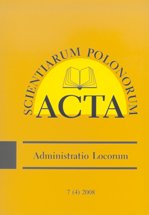METODYKA OCENY I LIKWIDACJI ZEWNĘTRZNEJ SZACHOWNICY GRUNTÓW ROLNYCH NA POTRZEBY ZWIĘKSZENIA EFEKTYWNOŚCI PROCESU SCALENIA I WYMIANY
METHODOLOGY FOR THE EVALUATION AND ELIMINATION OF THE EXTERNAL PATCHWORK OF AGRICULTURAL LAND FOR THE PURPOSE OF INCREASING THE EFFECTIVENESS OF CONSOLIDATION AND EXCHANGE PROCESS
Author(s): Przemysław LeńSubject(s): National Economy, Agriculture
Published by: Wydawnictwo Uniwersytetu Warmińsko-Mazurskiego w Olsztynie
Keywords: szachownica gruntów; scalenie i wymiana gruntów; kompleksowe programowanie prac scalenia gruntów; rozdrobnienie gruntów; grunty rolne
Summary/Abstract: Research conducted in Poland for many years now has shown that one of the main factors that hinder sound land management is defective spatial structure of agricultural land. A characteristic feature of rural areas in our country is that land is scattered in an external patchwork as a result of the widespread phenomenon of land fragmentation. The scale of this phenomenon is an important factor that limits the possibility of achieving satisfactory outcomes in land consolidation tasks. In this paper, a methodology for assessing the scale of an external patchwork of farmland is proposed. The goal of this method is to increase the efficiency of land consolidation and exchange procedures. On the basis of an analysis of the phenomenon of land fragmentation, we developed mathematical formulae which can be used to facilitate the complex process of programming of activities aimed at consolidating and exchanging land scattered over large areas. This method consists in selecting appropriately weighted parameters based on a dependency structure matrix and the Czekanowski diagram, which allow to determine the degree of fragmentation in a given area. Interpretation of the ordered diagram allows one to identify clusters of villages which need to be put under a common land exchange and/or consolidation programme. The land fragmentation data read from a Czekanowski diagram are an important supplement to priority rankings showing the order in which consolidation schemes should be implemented in a given area.This methodology can be successfully applied in practice in Poland. What guarantees its reliability is the fact that it uses data derived from real estate cadastre databases which provide a complete picture of the spatial and ownership structure of the analysed areas.The methodology proposed here allows one to achieve better consolidation outcomes as it focuses on eliminating defective patterns of land ownership.
Journal: Acta Scientiarum Polonorum Administratio Locorum
- Issue Year: 17/2018
- Issue No: 1
- Page Range: 41-50
- Page Count: 10
- Language: Polish

